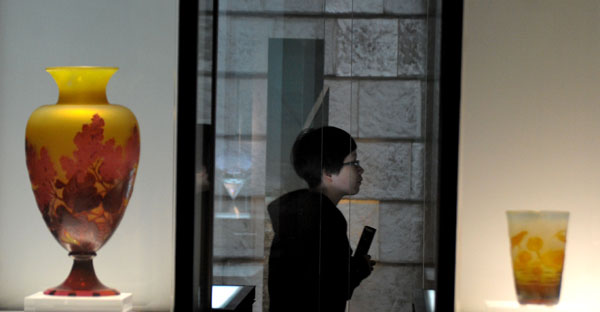Private museums struggle in tough market
Updated: 2012-09-04 01:59
By Shi Yingying in Shanghai (China Daily)
|
||||||||
Shortage of professionals, lack of funds are practical problems
The announcement of free admission to State-owned museums came as a shock to Wang Ziyong, owner of a private museum in Shijiazhuang, Hebei province.
Wang said the news is yet another setback to his snuff bottle museum, which depends on admission fees to make ends meet.
"They (the State-owned museums) enjoy subsidies above that of the total ticket revenue. We would have nothing if we decided to waive admission fees," said Wang.
 |
|
A visitor appreciates a piece of artwork at the private Liuli China Museum in Shanghai on March 4. The Shanghai municipal government is encouraging more private museums to offer free admission by allocating special funds and pairing them with State-owned museums. Six out of 16 private museums in the city are now free of charge. Provided to China Daily |
Increasing numbers of public museums have become free to the public since 2008, when the State Council encouraged museums to stop charging visitors.
"We have the practical problem of being unable to afford the more than 40,000 yuan ($6,310) monthly electricity bill for my museum during summer," said Wang.
Free museums would lure visitors to public museums and away from his, he said.
Zhang Mingbo, curator at the private Inner Mongolia Mingbo Grassland Culture Museum, said the industry’s problems are bigger than just electricity bills.
"There are so many things we need — money, recognition, and friendly tax policies — we are simply in a different league than State-owned (museums), we don’t have access to the resources they have, we don’t have the same support (from local government) as they have," he said.
China has witnessed a rapid increase in the number of private museums and art galleries over the past five years. The country’s 456 private museums, 13 percent of the nation’s museums, play an important role in China’s cultural life.
But compared with developed countries, cultural institutions in China struggle to stay alive.
According to the 2012 World Cities Culture Report by BOP Consulting and King’s College London, Shanghai has only 208 art galleries, less than one-fifth the number in Paris. The average number of art galleries shared by 100,000 Shanghai residents is 0.9, ranking Shanghai 11th among the 12 surveyed cities.
Shanghai boasts 477 libraries, second only to Paris, which has 830. However, Shanghai residents only borrow books from the library on average 2.5 times a year, greatly behind the figure in any Western country.
Newly opened museums and galleries face serious problems in remaining commercially viable.
"Quite a few museums closed their doors only a few years after opening," said Luo Xiaojun, the executive editor of 21st Century Business Insights.

 Relief reaches isolated village
Relief reaches isolated village
 Rainfall poses new threats to quake-hit region
Rainfall poses new threats to quake-hit region
 Funerals begin for Boston bombing victims
Funerals begin for Boston bombing victims
 Quake takeaway from China's Air Force
Quake takeaway from China's Air Force
 Obama celebrates young inventors at science fair
Obama celebrates young inventors at science fair
 Earth Day marked around the world
Earth Day marked around the world
 Volunteer team helping students find sense of normalcy
Volunteer team helping students find sense of normalcy
 Ethnic groups quick to join rescue efforts
Ethnic groups quick to join rescue efforts
Most Viewed
Editor's Picks

|

|

|

|

|

|
Today's Top News
Health new priority for quake zone
Xi meets US top military officer
Japan's boats driven out of Diaoyu
China mulls online shopping legislation
Bird flu death toll rises to 22
Putin appoints new ambassador to China
Japanese ships blocked from Diaoyu Islands
Inspired by Guan, more Chinese pick up golf
US Weekly

|

|






